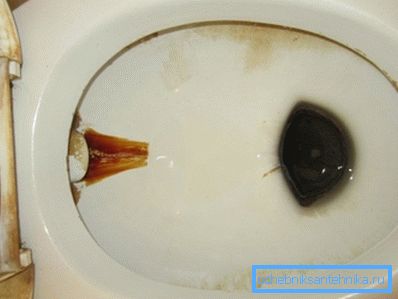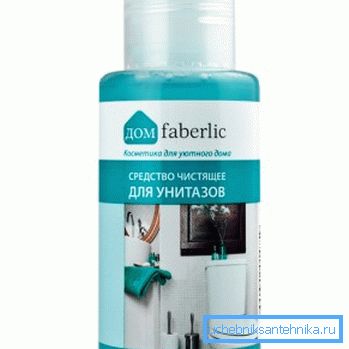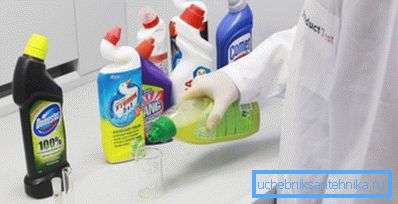Plaque in the toilet: how to deal with this problem with the
Even the most expensive and high-quality toilet without proper care over time loses its presentable appearance. Every day we are shown attractive ways to remove plaque in the toilet, and to effectively clean the stains.
But in fact, not all means are so magical, as we were promised, and the muscular man out of the package, alas, does not jump out. So, there is no one to rely on, you have to clean the toilet yourself, but what and how is worth finding out.

The main causes of sediments of any type
- Too high concentration of minerals and salts in water.. Very rarely, water for domestic use satisfies with its quality. As an example - a thick layer of scale in the kettle and in the washing machine. The same can be observed on plumbing accessories.
- Uncontrolled flow of water from the tank. If it is constantly leaking, get ready for frequent cleaning. The way out of the situation is the repair and adjustment of the flushing system. In most cases, this is easy to do with your own hands, you will save yourself from future problems.
- The rough (porous) surface of the toilet. Over time, the enamel collapses, microcracks, chips and pores appear in it. There loves dirt, rust and insoluble substances. If you are desperate and do not know how to clean the toilet from the yellow bloom, no funds help, it is better to change it to a new one.
- Often tenants observe a yellowish or brown tint of water from the tap. This is scale, rust particles from the internal surface of communications. Almost always the color changes after repairs or replacement of pipes in the house or on the riser. After several flushes, a rusty patina will immediately appear on the toilet.
Note! Deposits may appear from ignoring the flushing of water products of your life. If you do not wash off all the fact that you gave the toilet, not only plaque, but also the smell. Moreover, it will all increase exponentially, and it will be difficult to remove plaque on the toilet after it dries.
- Many are accustomed to pouring tea into the toilet, residual coffee, spoiled borscht or compote, and painted water after children’s art in watercolor. It also provokes an undesirable characteristic layer.
Prevention

The actual question - how to get rid of the raid in the toilet, without spending a lot of money on modern funds, bothers everyone. In order not to collect bright bottles with cleaning agents in the bathroom, you should pay attention to prevention.
After all, to prevent the problem is easier than to fix it.
- Make sure that the water in the tank is not leaking. Usually it is enough to repair or adjust the float, at least - the replacement of small items.
- Do not regret the old toilet of the middle of the last century, even if you are almost related to him, finally install a new one. Wrong enamel in cracks and pores and clean off difficult, but it gets dirty quickly.
- Do not forget and do not be lazy to flush with you. Temporary shutdown of water supply in the house is also not a reason to save something that the body got rid of.
- Before you clean the toilet from the plaque, find out its type. It may be dirt, urinary stone, paint, rust or scum.
- Buy in the store brush and plunger. Scrape the adhered pieces of waste immediately, preventing them from drying out.
- Install special containers with pills inside under the rim of the toilet bowl. They are sold in hardware stores, easily attached and soften the water, while disinfecting and eliminating odor.
- Wash plumbing accessories in a timely manner, make it a rule to clean the toilet regularly.
Effective means

To date, there are no problems with cleaning substances, made professionally in an industrial environment. Each is accompanied by instructions, which must be read, because you are dealing with household, but chemistry.
Note! Always wear gloves, goggles and a respirator before use. After cleaning, wash your hands thoroughly with soap and aerate the room.
Abrasive compounds

Immediately make a reservation - radical methods should be used carefully and infrequently.
Any abrasive agent scratches the enamel, accelerating its destruction.
- Scouring pads. Quite an effective tool for removing plaque in the toilet. It is advisable to purchase a washcloth with a sparing coating and rub it with surfaces without fanaticism, with soft movements.
- Various pasta. As a rule, they contain insoluble particles, as well as bleaching additives.
- Powders Familiar with many "Pemolyuks" and similar tools are also able to help. Powder poured on a dry surface, rubbed with a sponge, then rinse.
- Sand, emery skin will wash away the deposit even under water. Extreme ways, but they also have the right to exist. Especially if you no longer feel sorry for the toilet that has seen the views, and the price of household compositions seems unreasonably high.
Chemical substances

The basis of liquids is caustic soda, chlorine, acid. Therefore, before you remove plaque from the toilet, open the windows and take care of protection. Fluids and gels like “Domestos” and “Whiteness” have proven themselves well. But the smell can be understood that too much to get involved in the compositions is not worth it.
Note! Keep potent substances out of the reach of pets and children. Before you wash the toilet from the plaque, read on the packaging methods for getting rid of the liquid in the eyes and on the skin.
Recipes of our grandmothers

Supporters of environmentally friendly ways are advised not to spend money on publicized funds. It is better to turn to the tricks of our mothers and grandmothers.
Oh, they knew how to remove the yellow bloom from the toilet without harm to others.
- Baking soda. It costs a penny, is completely harmless and works great.
- Fine salt. Not only cleans, but also disinfects, which is important.
- Lemon acid. Eats lime and yellow plaque without difficulty.
- Laundry soap. Paired with a finely abrasive washcloth will help create cleanliness.
Conclusion
Keep the bathroom clean, maintain the toilet in perfect condition, and then you will not have to change the plumbing almost every year.
Our video in this article will help you understand all the intricacies of the means of dealing with the attack.